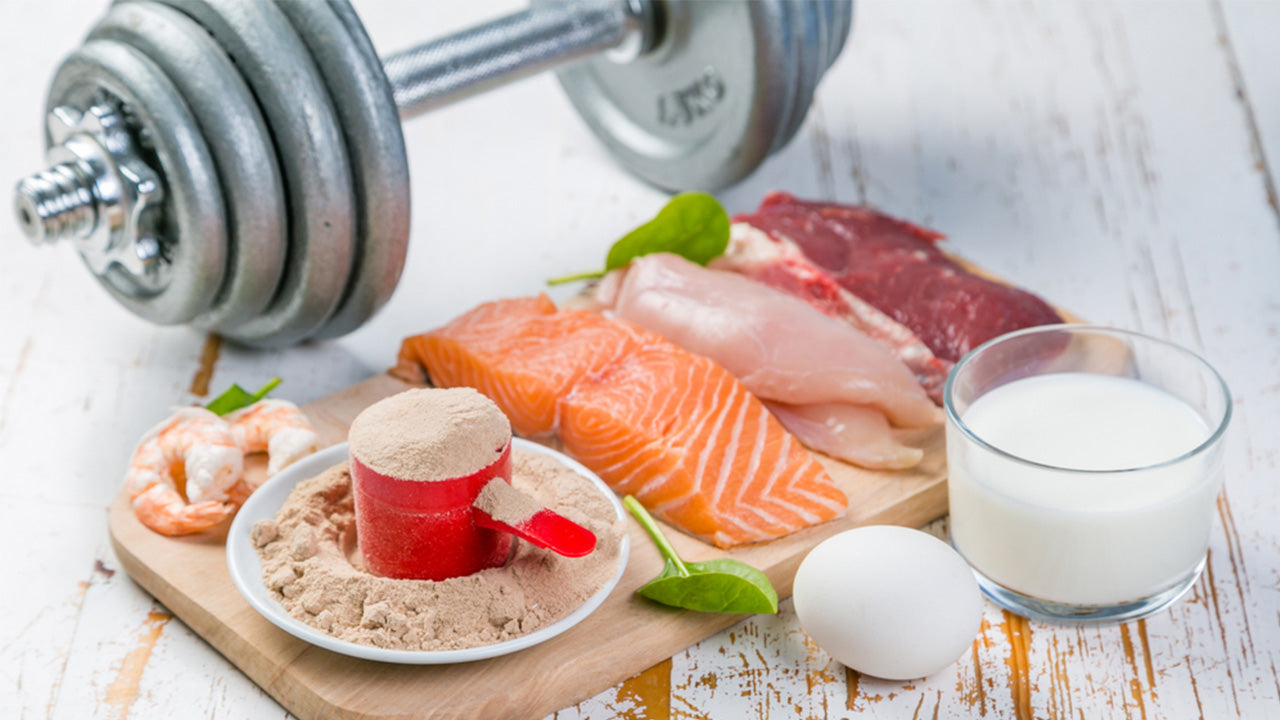BCAAs and EAAs—Which Amino Acid Supplement Is Right for You?
 By: by Amino Science
By: by Amino Science

Discussions of amino acids are rife with acronyms, but the two most common just might be BCAAs and EAAs.
If you search for “essential amino acids” on Google, the top results will be filled with sites proclaiming the health benefits of branched-chain amino acids, or BCAAs. And you'll also discover just as many sites where prominent experts in sports nutrition claim that BCAAs are worthless and the true heroes of the amino acid world are essential amino acids, or EAAs.
Understandably, you may be left wondering about the differences between BCAA supplements and EAA supplements. With all the strident advertising claims, it can be quite challenging to determine the basic facts about both types of amino acids, let alone which supplement option will be right for you.
Essential Amino Acids (EAAs) Explained
Essential amino acids (EAAs) belong to a broader class of amino acids involved in protein synthesis and fittingly referred to as proteinogenic amino acids. One of the primary ways your body uses these amino acids, which have been nicknamed the building blocks of protein, is for muscle growth.
The class of proteinogenic amino acids can be split into two primary subcategories: essential amino acids (EAAs) and nonessential amino acids. Nine amino acids have been classified as essential because the human body cannot synthesize these on its own, meaning you must obtain them from dietary protein sources or nutritional supplements. The nine essential amino acids are:
| Leucine | Lysine | Tryptophan |
| Isoleucine | Threonine | Histidine |
| Valine | Phenylalanine | Methionine |
While the nonessential amino acids undeniably contribute to your overall health and well-being in crucial ways, the human body can produce them from a combination of essential amino acids, carbohydrates, and fats, rendering them comparatively nonessential.
EAAs play a variety of important roles in the body, including acting as precursors for the production of brain neurotransmitters and supporting immune function. However, as I mentioned above, the main role of EAAs is as constituents of proteins, including muscle protein.
Since all proteins in the body are continually broken down and re-synthesized, an adequate supply of all the EAAs is required or body protein will be lost. Most of the EAAs in body protein that is released as a result of protein breakdown are available for reincorporation into protein. However, approximately 15% of the EAAs released from protein breakdown are oxidized, which means they are irreversibly lost. The EAAs that are oxidized must be replaced through your diet since they cannot be produced in the body.
Branched-Chain Amino Acids (BCAAs) Explained
Branched-chain amino acids (BCAAs) exist as a subcategory of essential amino acids. The three branched-chain amino acids—leucine, isoleucine, and valine—got their name because of their distinctive, branch-like chemical structures.
When it comes to BCAA benefits, leucine dominates. Researchers have proposed that leucine holds a variety of regulatory roles in the body. Initial interest in the unique qualities of leucine concerned its primary role in stimulating muscle protein synthesis, or the building of new muscle tissue. We can trace this interest back to a 1975 study published in the Journal of Clinical Investigation that demonstrated leucine’s capacity to stimulate protein synthesis in isolated rat muscle.
Then in 1988, two scientists named Garlick and Grant conducted studies with rats to explore the possibility that the same effect could be elicited in a living creature. Their findings showed that a mixture of BCAAs could increase the muscle protein synthesis response to insulin.
The next major advance came in 2000 when the Journal of Nutrition published a study that investigated the potential mechanism by which leucine acts as a stimulator of muscle protein synthesis. The study authors showed that leucine ingestion stimulated muscle protein synthesis in rats and that the increase in synthesis was accompanied by the activation of several molecular factors (including the mTOR pathway) within the muscle cell that are required for initiation of the process of protein synthesis.
Researchers refer to these factors collectively as the initiation factors, and the entire molecular processes involved in the initiation of protein synthesis as anabolic signaling. The takeaway, at this point, was that leucine can activate anabolic signaling.
But an interesting phenomenon occurred when humans entered the research picture. When scientists began to study the beneficial effects of leucine on human subjects, it became evident that providing leucine alone disrupted the balance of plasma amino acids. Most notably, increased availability of leucine not only caused increased oxidation of leucine but the accelerated oxidation of the other two branched-chain amino acids as well.
Because providing leucine alone created isoleucine and valine deficiencies, supplement companies typically formulate their proprietary blends of BCAAS to contain all three amino acids even though no special qualities of either valine or isoleucine have been identified.
Based on both historic and recent studies, we now have a good grasp of what happens when humans take branched-chain amino acid supplements. Scientists have shown that taking between 2 and 4 grams of leucine as part of a complete BCAA dietary supplement may positively influence a variety of physiological endpoints, including increased muscle mass, improved recovery from exercise, and enhanced mood and cognitive performance during prolonged exercise.
There is no doubt that leucine can be considered a nutraceutical, a designation that honors its regulatory effects beyond its role as one of the building blocks of body proteins. It's clear that increasing the amount of leucine you consume each day can help you to build muscle and optimize your exercise performance, among other benefits.

What You Should Know About Muscle Protein Synthesis
As I briefly noted in the section on EAAs, one of the major contributions amino acids make in the human body is the stimulation of muscle protein synthesis.
In fact, researchers have discovered that the availability of the essential amino acids determines the rate of muscle protein synthesis. That means that the smaller the number of available EAAs, the slower the rate of muscle protein synthesis, and the larger the number, the faster the rate.
Every time you eat a food that contains all nine essential amino acids, or take an EAA supplement, you stimulate muscle protein synthesis. The degree of stimulation of muscle protein synthesis by EAAs depends on the dose. The more EAAs ingested, (with a maximum threshold of 15 grams), the greater potential for building muscle. Conversely, if EAAs in the blood drop below a certain level, then your muscle-building potential becomes compromised. You can learn more about this process in my book, A Guide to Amino Acid and Protein Nutrition: Essential Amino Acids for Everyone.
The most important takeaway about the relationship between amino acids and muscle protein synthesis is that all the essential amino acids are required to make new protein. This can best be understood by thinking about how proteins are made.
Each protein in the body is a long string of amino acids linked together in a specific order. Protein is produced by hooking together amino acids one by one in the order dictated by messenger RNA in the cell. If a point is reached where the next amino acid due to be incorporated into the chain is not there, production of the protein will stop.
Where Do the Amino Acids for Protein Synthesis Come From?
The proteins that make up your muscles constantly break themselves down and then build themselves back up. The muscle breakdown process releases amino acids, which your body then recycles and uses for the synthesis of new proteins. In the basal state, the resting metabolic state of the body in the morning after 12 hours of fasting, amino acids released by muscle breakdown serve as the main source of amino acids for protein synthesis. Regardless of your metabolic state, approximately 85% of the amino acids released by muscle protein breakdown are re-used in the protein synthesis process.
There are two ways to increase the rate of protein synthesis: either you find a way to more efficiently reutilize the amino acids from protein breakdown, or you make more essential amino acids available by increasing your consumption of EAAs.
The bottom line? The simplest and most effective way to ensure that all the EAAs will be available for muscle protein synthesis in the optimal ratios is to increase your intake of essential amino acids.
BCAA or EAA Supplements—Which Are Better for Muscle Growth and Muscle Repair?
Now it's time to get down to brass tacks and settle the question of EAAs vs. BCAAs. To do so, let's review what we've discussed so far. All three branched-chain amino acids—leucine, valine, and isoleucine—are also essential amino acids. They're also all components of muscle protein. Plus, leucine can increase the efficiency of protein synthesis by activating the initiation factors. So, does that mean increasing your intake of leucine with a BCAA supplement is the best way to achieve desirable health outcomes like the stimulation of the synthesis of new muscle protein?
Not quite. Remember, if only BCAAs are consumed, they are limited in their ability to stimulate muscle protein synthesis. That’s because all the EAAs are required for a complete protein to be produced, and in the basal state, the only source of EAAs is from protein breakdown. Since most of those EAAs are already reincorporated, the maximal increase in protein synthesis is limited by the availability of the other EAAs. For this reason, research has shown that taking BCAAs alone has either no effect or a minor effect on the rate of muscle protein synthesis in human subjects.
There is no question that BCAAs are important for many functions in the body, including protein synthesis. However, the full benefit of BCAAs cannot be achieved if they are taken by themselves, because you cannot make a complete protein out of just three amino acids. The maximal effectiveness of the BCAAs is only achieved when they are taken along with the other six EAAs. Only a mixture of all the EAAs can provide a sustained stimulation of muscle protein synthesis. The nonessential amino acids in protein can be made in the body and are therefore not required in a dietary supplement.
A non-scientific analogy might be helpful in understanding the difference between BCAAs and EAAs. Think of EAAs like different players on a football team. In this analogy, leucine is the quarterback that calls the signals and is the most important player on the team—what team wins without a good quarterback? However, a team of just quarterbacks wouldn’t be very successful, and neither is an amino acid supplement made up entirely of grams of leucine.
All the positions on the team have an essential role to play, and without enough players for each position, the team will fail. Similarly, all the EAAs are required for the effects of leucine to translate to increased production of muscle protein. Consumption of a dietary supplement containing a balanced mixture of all the EAAs that includes a generous proportion of leucine is necessary for maximal results. You can find complete EAA supplements designed for your most important health concerns here.

Up to 25% off Amino
Shop NowTAGS: supplements
Join the Community
Comments (0)
Most Craveable Recipes




 833-264-6620
833-264-6620



















